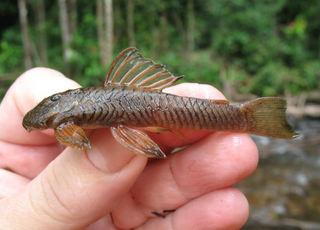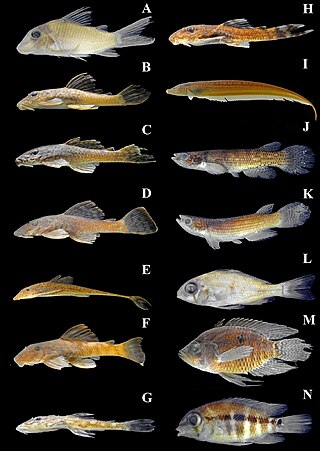
Peckoltia is a genus of small South American armored suckermouth catfishes. Many of these fish are popular aquarium fish.

Loricariinae is a subfamily of the family Loricariidae of catfish. This subfamily is divided into two tribes and about 30 genera. They are mainly native to freshwater habitats in South America, but there are also several species in Panama and a single (Fonchiiichthys) in Costa Rica.
Harttia is a genus of armored catfishes native to South America.

The Hypostominae are a subfamily of catfishes of the family Loricariidae. Most members are restricted to tropical and subtropical South America, but there are also several species in southern Central America. Hypostomus plecostomus, which is popular in the aquarium trade, has been introduced to several regions far from its native range.
Cteniloricaria is a genus of armored catfishes native to northern South America.

Guyanancistrus is a genus of suckermouth armored catfishes.

Panaqolus is a genus of small catfish in the family Loricariidae native to rivers in tropical South America. Its members were formerly thought to belong to a clade of small-sized species in the genus Panaque, until this genus was separated from Panaque in 2001. At times it has been considered a subgenus of Panaque, and the validity of the genus has been disputed by various authors and sources. Pseudoqolus koko was formerly considered to be a member of this genus, although it was reclassified as a member of the currently monotypic genus Pseudoqolus by Nathan K. Lujan, Christian A. Cramer, Raphael Covain, Sonia Fisch-Muller, and Hernán López-Fernández following a 2017 molecular phylogenetic analysis.

Guyanancistrus nassauensis is a species of catfish belonging to the family Loricariidae, the suckermouth armored catfishes. It is discovered in 2005 and formally described in 2018. G. nassauensis is a rare species, highly endemic to the Nassau Mountains in Suriname, and is threatened with extinction by proposed or ongoing mining activities.
Harttia fluminensis is a species of armored catfish where it is known only from the Coppename River drainage in Suriname.
Pseudoqolus koko is a species of catfish in the family Loricariidae and the only species in the genus Pseudoqolus. It is a freshwater fish native to South America, where it occurs in the Maroni basin. It is usually found on or near stony substrates in the main river channel at a depth of around 2 m. The species has been collected alongside multiple other loricariid species, including Hemiancistrus medians, Peckoltia otali, Pseudancistrus barbatus, Harttia guianensis, Loricaria cataphracta, and Rineloricaria stewarti. It is noted that the gut contents of one specimen of this species contained primarily spicules and sponge fragments, indicating that it may feed on freshwater sponges. The species reaches 9 cm SL.
Peckoltia capitulata is a species of catfish in the family Loricariidae. It is native to South America, where it occurs in the Approuague River in French Guiana. It was initially collected from an area of the river with a swift, strong current that was noted to be unusually turbid at the time of collection due to illegal gold mining in the area. The species reaches 7.6 cm SL. Its specific epithet, capitulata, is derived from Latin and reportedly refers to the characteristically small head of the species.
'Pseudancistrus' megacephalus is a species of catfish in the family Loricariidae. It is of uncertain and disputed classification.

Cryptancistrus similis is a species of catfish in the family Loricariidae and the only member of the monotypic genus Cryptancistrus. It is a freshwater fish native to South America, where it occurs in the upper Paru de Oeste River in Brazil. The species reaches 6.2 cm in standard length. It was described in 2018 by Sonia Fisch-Muller, Jan Mol, and Raphael Covain as part of a taxonomic review of the genus Guyanancistrus, which Cryptancistrus was found to be distinct from but closely related to. Its specific epithet, similis, is derived from Latin and references the species' similarity to the species of Guyanancistrus, specifically Guyanancistrus brevispinis.

Cteniloricaria napova is a species of catfish in the family Loricariidae. It is native to South America, where it occurs in the upper Paru de Oeste River basin in Suriname. The species reaches 12.9 cm in standard length and is believed to be a facultative air-breather. Its specific name, napova, is derived from the Tiriyó language and means "thank you", honoring the Tiriyó people of Sipaliwini District for collecting and providing specimens of the species.
Harttiella intermedia is a species of catfish in the family Loricariidae. It is native to South America, where it occurs only in the headwaters of Crique Grand Leblond on Trinité Massif in French Guiana. The species reaches 3.5 cm in standard length. It was described in 2012 as part of a taxonomic review of members of the loricariid tribe Harttiini native to the Guianas.
Harttiella janmoli is a species of catfish in the family Loricariidae. It is native to South America, where it is known only in a small forest creek near Cottica Mountain in French Guiana, at an elevation of 515 m above sea level. The species reaches 4.7 cm in standard length. It was described in 2012 as part of a taxonomic review of members of the loricariid tribe Harttiini native to the Guianas.
Harttiella longicauda is a species of catfish in the family Loricariidae. It is native to South America, where it occurs in mountainous areas in the vicinity of Trinité Massif and Balenfois Massif in northern French Guiana. The species reaches 5.2 cm in standard length. It is known to occur alongside the species Characidium fasciadorsale, Krobia itanyi, Lithoxus planquettei, and Rhamdia quelen, as well as members of the genera Ancistrus, Guyanancistrus, Melanocharacidium, and Rineloricaria. The species was described in 2012 as part of a taxonomic review of members of the loricariid tribe Harttiini native to the Guianas.
Harttiella lucifer is a species of catfish in the family Loricariidae. It is native to South America, where it occurs in the vicinity of Lucifer Massif and Galbao Massif in central French Guiana. The species reaches 4.3 cm in standard length. It is known to occur alongside the species Anablepsoides igneus and members of the genus Ituglanis. The species was described in 2012 as part of a taxonomic review of members of the loricariid tribe Harttiini native to the Guianas.
Harttiella parva is a species of catfish in the family Loricariidae. It is native to South America, where it is known only from a small forest creek in the Atachi Bakka Mountains in French Guiana. The species reaches 3.1 cm in standard length. It was described in 2012 as part of a taxonomic review of members of the loricariid tribe Harttiini native to the Guianas.
Harttiella pilosa is a species of catfish in the family Loricariidae. It is native to South America, where it occurs in the Orapu River basin in the Tortue Mountains of French Guiana. The type locality of the species is the area directly upstream and downstream of a 30 m high waterfall. This environment is a 10 m wide river channel with shallow, clear water and a substrate composed of gravel, pebbles, boulders, bedrock, and iron-rich sand. The species reaches 4 cm in standard length. It was described in 2012 as part of a taxonomic review of members of the loricariid tribe Harttiini native to the Guianas.






